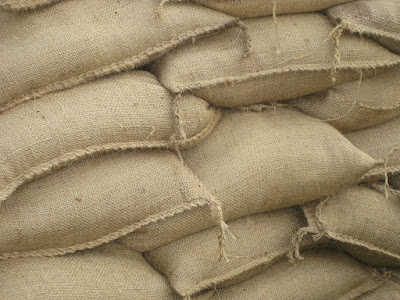Spinning
and Weaving of Jute
Yashashree Ingle
Department of Textile
Technology
Veermata Jijabai
Technological Institute,Mumbai,India
The
most commonly operated jute spinning consist of two stages of carding followed
by three stages of drawing and finally a spinning stage.
In
the first carding stage, the long lengths of fiber are passed through a breaker
card, which breaks the continuous mesh of fiber into separate fragments.
The following flow
shows the process spinning for 100% jute yarn:
 |
| Fig-Process flow of Jute Spinning |
In
the 3 drawing stages the movement of fiber is controlled by gill pins fixed to
faller bars. At all stages, drafting is accompanied by appropriate doubling of
input slivers. More recently, the open draft system is introduced whereby fiber
control was effected either by double apron arrangement or single apron.
Modern development:
- Development has also taken place in drawframe, in addition to the fixed drawframes autolevellers.
- This machine automatically adjust the draft according to the thickness of output sliver and maintain a uniform density of sliver.
- High speed ring spinning finer jute yarns are manufactured by UK and France.
- Also SITRA has developed low cost spinning machine for fine count jute yarn.
- The SITRA at Coimbatore has developed ring spinning frame to spun 100% fine jute yarn.
Some of the features of the SITRA jute frame include:
- Double slided machine with sliver feeding creel arrangement (200 spindle / machine)
- Optimum spinning geometry with 45 degree roller strand angle.
- Angle of yarn pull is 28 degree and spinning angles are 21 degree( lappet bottom position) and 25 degree( lappet top position)
- Draft range is 15 to 20
- Spindle speed 6000 to 65000rpm
- Twist range is 3.0 to 12.0 TPI
- Counts in range of 8 to 10 Ne
Fabric Production (Weaving and
specifications):
Jute
yarn can be woven on automatic power looms, shuttle less looms or hand looms.
Jute is widely used because it is inexpensive, stronger and produce in a large
quantity.
The
following are different products in India:
- Yarn twinner 13%
- Diversified Products 9%
- Hession cloth 23%
- Carpet cloth 19%
- Sacking 64%
Winding:
The
main purpose of warp yarn winding is to transfer yarn from the spinners or
doublers package to another which can be used in the creel of the warping
machine. ATIRA have developed an electronic yarn clearer this micro controller
based system for the detection and clearing of objectionable faults such as
thick and thin places in the blends of jute yarns.
Warping
and Sizing of Jute Yarns:
The
2 types of warping sectional and beam warping are used to prepare jute and jute
blends yarns for weaving. Jute yarns needs to be sized because they are hairy
and they have low extensibility under tension. In Indian jute industry tamarind
kernel powder( TKP) is used exclusively as the only suitable sizing material.
Weaving of Jute Yarn:
Shuttle
Loom:
The
shuttle loom is the oldest type of powerloom, it is effective but now-a-days it
is not much used because it comes with certain disadvantage. They operate at
110 to 230 PPM which is lower than modern looms also they produce noise.
Shuttless
Looms:
Gripper
projectile loom and Rapier loom can be effectively used to weave jute yarn of
any nature. There is only 1 kind of projectile loom used in the jute industry.
Air jet looms with either single nozzle or multiple nozzle type.
Hand
looms:
With
the increase in diversification of the use of jute in various non traditional
applications the end uses such as curtains, upholstery and certain heavier
furnishing fabrics provided by the handloom and it is still in practice.






2 Comments
Thanks for sharing really helpful.
ReplyDeleteThis is a fantastic and detailed overview of the jute spinning and weaving process. You've done a great job highlighting the unique challenges of working with this robust natural fiber, particularly its need for specific moisture and tension control.
ReplyDeleteThe point about the importance of a strong, uniform yarn for weaving is absolutely critical. This is where the quality of the warp preparation stage truly determines the efficiency of the entire operation. For jute mills looking to maximize output and minimize downtime, investing in robust, purpose-built warp preparation equipment is essential. It ensures the yarn can withstand the high tension of the loom, directly impacting the quality of the final sacking or fabric.
Thanks for sharing such an informative piece on this important industry.
—
McCoy | Durability in Textile Machinery